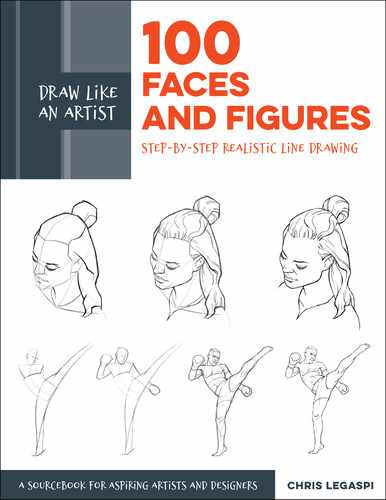HOW TO USE THIS BOOK
There are many ways to draw figures and faces. This book presents the method that I use as a life-long professional artist and teacher. The steps can be copied to achieve a finished drawing. If you study the steps, you will learn how my drawing process and my approach can be applied to any subject—not just figures and faces. The steps below describe my process and drawing philosophy and offer suggestions on how to interpret the instructions in this book.
Suggested Materials
• Graphite pencil
• Ballpoint pen or felt tip pen
• Plain office paper, Bristol, or any paper 80 lb or more
• Eraser
Basic Drawing Process
Begin the drawing with a graphite pencil so you can sketch freely and make mistakes that can be easily erased. Once you are satisfied with the pencil sketch, go over the drawing with a pen. When you erase the pencil lines, you are left with a clean, finished line drawing.
Using Gesture Lines
Gesture is the movement and action of the pose or form. Even faces have gesture. Gesture adds life to a drawing, which is why it is the first and most important step. Make your gesture lines long and try to describe the big movements first, then move on to the smaller movements and actions.

STEP 1

STEP 2
In this example of a baseball pitcher, Step 1 is the main gesture or primary action of the pose. Step 2 describes the secondary gestures of the arms and legs.
Constructing the Image
Once you describe the movement and action of the form with gesture lines, construct the drawing. Steps 3 and 4 are the construction steps. In this stage of the drawing, try to describe the three-dimensional quality of the forms. For example, draw eggs and spheres for the head or torso and cylinders for the arms.
In the runner example, Step 4 describes the construction of the limbs and body. In the girl’s head, Step 3 starts the construction with more simple forms of the head and face, while Step 4 constructs the smaller forms and the features.

STEP 3

STEP 4

STEP 4
Adding Details and Clean up
Small forms and details come last, which happens in Step 5. Here you add things like individual fingers, wrinkles, and folds in fabric. Once you’re happy with the details, go over your drawing with a pen and erase the pencil lines. This leaves only the clean, finished line drawing, which is Step 6.
In the construction worker, I start adding details in Step 4 and then use a pen to add more details in Step 5 before erasing all the pencil lines. For the bearded man, Step 5 begins the details and Step 6 is the finished line drawing after erasing the pencil lines and with more details drawn in pen.

STEP 4

STEP 5 (Final)

STEP 5

STEP 6 (Final)
If you’re new to drawing, please start by copying the steps provided to the best of your ability. As you become more advanced, you can apply the steps and process to any subject or form you want to draw.
